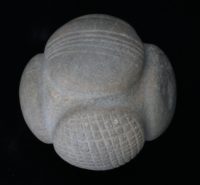 An intricately carved Neolithic stone ball discovered in the Ochil Hills near Sherriffmuir in Perthshire, central Scotland, will stay in its native soil after a fundraising campaign secured it for the Perth Museum and Art Gallery. The 4,000-year-old stone was declared Treasure Trove according to Scottish law and allocated to the Perth Museum, but because budget cuts have slashed its acquisitions budget, the museum had to raise money to secure it. The Perthshire Society of Natural Science opened an online crowd-funding campaign and was able to raise £1625 well before the March 26th deadline. A grant from the National Fund for Acquisitions chipped in matching funds.
An intricately carved Neolithic stone ball discovered in the Ochil Hills near Sherriffmuir in Perthshire, central Scotland, will stay in its native soil after a fundraising campaign secured it for the Perth Museum and Art Gallery. The 4,000-year-old stone was declared Treasure Trove according to Scottish law and allocated to the Perth Museum, but because budget cuts have slashed its acquisitions budget, the museum had to raise money to secure it. The Perthshire Society of Natural Science opened an online crowd-funding campaign and was able to raise £1625 well before the March 26th deadline. A grant from the National Fund for Acquisitions chipped in matching funds.
Stone balls carved in the Late Stone Age (around 3200 – 2500 BC) are a big thing in Scotland. Out of about 530 that have been found in Northern Europe, 520 of them were found in Scotland. More than a third of them are in the National Museums Scotland in Edinburgh. That the Sheriffmuir Ball will remain local is all the more significant because it is one of fewer than 50 of the known Neolithic balls to have decorative carving and it’s a particularly elaborate one. It’s also one of the most southernly balls ever found in Scotland.
Since the first one was discovered 150 years ago, archaeologists have debated what the purpose of the balls might have been. None of them have been found in or near burial, so they were not used as funerary offerings or grave goods. They could have been weapons, tools or status symbols, or perhaps a combination of any of those.
They are roughly the same size and while remaining circular in dimensions, they have been carved to have lobes or knobs. The ones that are decorated have spirals and curved carved into the surface. The Sheriffmuir Ball has a grid pattern on one lobe, five parallel lines on another and an off-center circle on a third.
You can explore it in the 3D model created by National Museums Scotland: